This Channel wreck site is one for trimix divers, but it’s a submarine with history and in great condition, says JOHN LIDDIARD. Illustration by MAX ELLIS
AT 58 METRES TO THE SEABED, this month’s tour is a bit deeper than usual, in the depth range where a normoxic trimix is best for the dive. But U480 is an almost unique variation of a type VIIC U-boat, in excellent condition considering that the most likely cause of its loss was striking a mine, and provides a wonderful display of all the external machinery fitted.
Our dive begins at 55m, just aft of the conning tower (1), where the skipper of Wight Spirit, Dave Wendes, consistently hooked the shot two days’ running.
The bow is just to the west of north, so on a high-water slack the stern is to the left from the lay of the shotline.
As is the case with many U-boats, the wreck lies canted to one side – in the case of U480, to starboard. The wooden decking has rotted, to leave plenty of holes through.
It is difficult to make out the edges of the outer hatch, but the inner pressure hatch to the motor room can be seen through these holes, sloped to facilitate the loading of torpedoes for the aft tube.
A little further aft, the wooden deck has completely gone, revealing the exhausts (2) from the twin diesel engines.
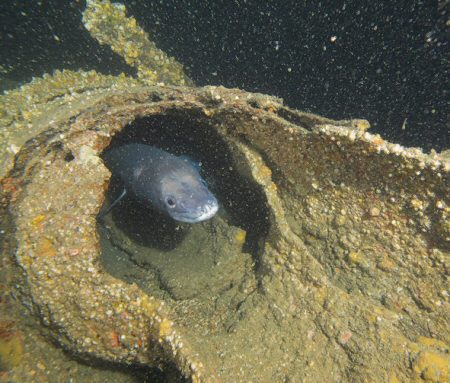
These lie along the outside of the pressure hull, almost to the point at the aft end where the stern has broken off.
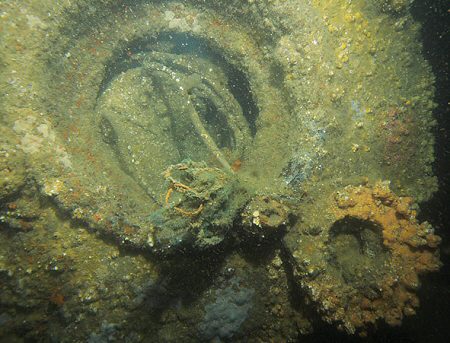
A T-shaped bar (3) rising from the upper side of the hull is part of the steering mechanism, and would have been connected by rods beneath the deck to the twin rudders further aft.
The list of the wreck leaves the port propeller-shaft standing above the seabed, with the prop still attached (4).
The tail of the stern (5) has broken off, and lies on its starboard side in 58m, slightly to starboard of the line of the wreck, with the port hydroplane pointing vertically upwards. The control rod for the hydroplane dangles from the break.
The starboard propeller-shaft and prop (6) are flat on the seabed between the tail-section and the main body of the wreck. Also on the seabed, between the propeller-shafts, is the single aft torpedo tube (7), broken in two and wrenched from the pressure hull to leave a gaping hole in the approximate centre.
This would have originally exited the boat between the twin rudders.
Overall, this damage appears to show that U480 hit the seabed stern first, so that, dragged by the tide, the tail section and torpedo tube broke from the hull.
Heading forward along the starboard side of the wreck, various debris from the deck and conning tower has fallen to the seabed. First we see a cylindrical waterproof container (8), then a compressed air cylinder (9) and a pair of tapering conical gun-mounts (10) and (11). Between these is another cylindrical container, then, just forward, a part-circle formed by cladding from the conning tower (12).
Our tour now returns to the deck of U480 just aft of the conning tower, where a heavy tubular support (13) from one of the gun-mounts stands out from the hull. This is where Rob and Heinz Graafsma left a memorial tablet to their uncle Heinz Steffens, one of the 48 crew who all died on U480 (Unfinished Business On A U-Boat, July 2008).

Only the heavily built pressurised core of the conning tower remains (14), rising as shallow as 51m. At the back and to either side, tubes along the outside of the tower are air intakes for the diesel engines.
Then, from the top of the tower, we have the larger attack periscope, a radio direction-finding loop, its support canted to port, and, at the front of the tower, the smaller search periscope.
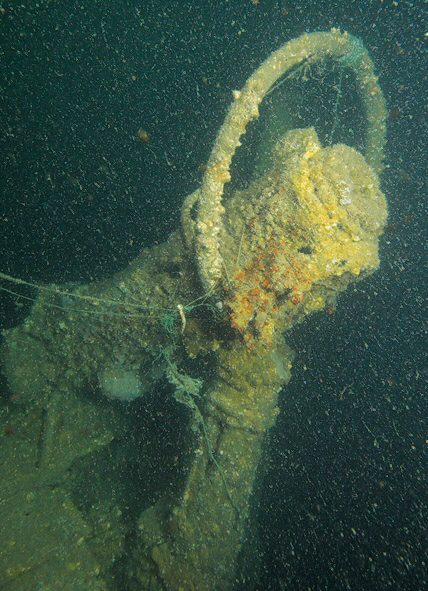
Back at deck level, forward of the conning tower, the snorkel (15) lies securely stowed in its recess along the port side of the deck.
U480 was the first operational U-boat to be fitted with a snorkel, and in use this would have hinged up and clamped to the front of the conning tower.
Almost level with the top of the stowed snorkel, the wooden decking has decayed enough to show the domed forward hatch (16) below. The hatch is angled backward to facilitate loading of torpedoes into the forward torpedo-room.
The deck forward to the bow has completely decayed, to leave cradles for external torpedo stowage (17) exposed. The cradles are empty, and as late in the war as the U480 met her demise, external torpedo stowage is unlikely to have been in use. Surfacing for long enough to reload was just too hazardous for U-boats by 1945.
A tapering inward of the hull indicates that inside the cladding the pressure hull is coming to an end.
Below the rotted deck level, control rods (18) exit the hull vertically and connect forwards to the forward hydroplanes via bevelled gears.
The wooden cladding of the deck recovers, then steps down (19) where the forward trim tank is missing. Dropping down the bow, the outer doors of all four forward torpedo tubes (20) are closed.
Back along the port side, the bow hydroplane (21) juts out from the hull. The list of the wreck means that the corresponding starboard hydroplane is below the seabed.
On the way back to the conning tower, look closely at the side of the hull. It isn’t bare steel, but a thin Alberich rubber coating, designed to reduce U480‘s visibility to sonar, and named after a dwarf with a helmet of invisibility in Wagner’s Ring cycle.
Some patches are peeling off, so you can see just how thin it is. This experimental coating was fitted to only 12 U-boats, U480 being the first type VIIC to have it.
With the tide by now picking up, a convenient place to launch a delayed SMB for the long decompression is the top of the attack periscope (22) at 51m.
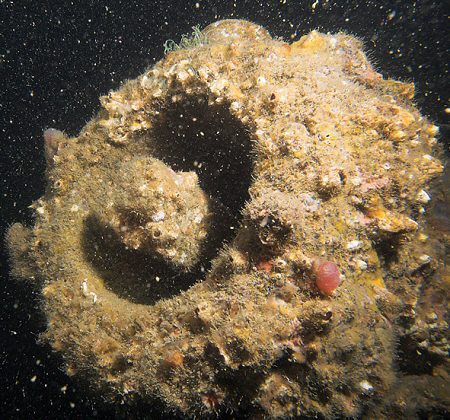
MYSTERY DEMISE OF INVISIBLE SUB
U480, U-boat. BUILT 1941, SUNK 1945
The ocean-going VIIC attack U-boat U480 was built as the last of five new boats ordered in April 1941. She gained from being the last of the bunch, because several improvements in undersea warfare were on board when she was launched on 14 August, 1943, writes Kendall McDonald.
For example, the most modern snorkel equipment was available to Oberleutnant Hans-Joachim Forster when he took command that October. More importantly, U480 was the first U-boat to have her entire hull covered with 4mm of a black, rubbery, anti-Asdic coating called Alberich. This was designed to neutralise the Allies’ highly effective echo-sounding detection of submerged submarines.
Alberich worked well, but was best at depths of 150m, which wasn’t much use when Forster was sent to operate in the shallow Channel waters from Brest on 3 August, 1944.
He torpedoed and sank the 925-ton Canadian corvette HMS Alberni on 21 August, killing 59 men. The next day he did the same to the 850-ton RN fleet minesweeper Loyalty, killing another 20.
On 23 August, the 7134-ton British Liberty ship Fort Yale, which had been mined and was now being towed from Normandy’s Juno Beach towards Portsmouth, was torpedoed and sunk by U480.
Forster was recalled to Norway after his “score sheet” listed 14,000 gross tons of Allied shipping and two frigates sunk. He and his crew received heroes’ welcomes. Admiral Donitz presented him with the Knight’s Cross on 4 October, 1944.
U480 and her crew of 47 headed for the Channel on what was to be her last patrol on
6 January, 1945. On 24 February, the 1644 -ton British collier Oriskany, part of Convoy BTC 78 from Newport to London, was torpedoed by a U-boat near Land’s End.
The convoy escorts started hunting for the sub, and depth charges brought pieces of the Alberich material to the surface. The Admiralty said that this was proof that U480 had been destroyed, but it was later discovered that the U-boat was more likely to have been U1208.
So what happened to U480 ? The wreck was not found until 1994, when a Type VIIC was located 16 miles off Anvil Point, near Swanage.
While potting in the area in October 1994, the Ballett family divers of Poole discovered a U-boat that had obviously hit a mine. It was coated with the Alberich material.
It was dived by several dive teams, including John, Steve and Mike Ballett and divers from French Telecom. In 1998, the marine archaeologist and British submarine expert Innes McCartney, with help from the Royal Navy, was able to dive the wreck and positively identify it as U480.
A range-finder engraved with a swastika, which had been blown off the conning-tower, is displayed in the Blue Boar Inn at Poole.
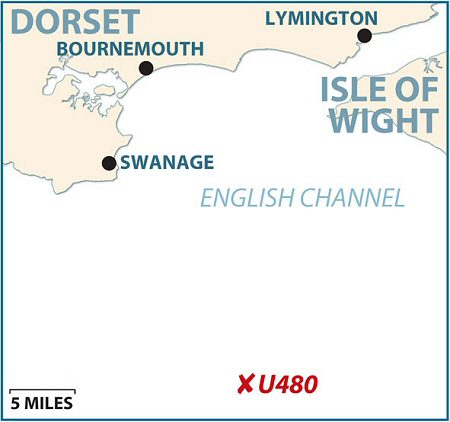
TOUR GUIDE
GETTING THERE: From the roundabout at the M27 junction 1, turn south on the A337 through Lyndhurst and continue to Lymington. Head towards the town centre until the road takes a sharp right turn uphill to the high street. Rather than go up here, continue straight on and follow the road downhill to the river and marinas.
HOW TO FIND IT: The GPS co-ordinates are 50 22.144N, 001 44.240W (degrees, minutes and decimals). The wreck lies across the tide, with its bow just to the west of north.
TIDES: Slack water is essential, and occurs 25 minutes after high water Dover, or 30 minutes before low water Dover. On spring tides, slack is very short, and can be a few minutes later than this.
DIVING: Wight Spirit, skipper Dave Wendes, 02380 270390.
AIR: Trimix and other gases available from Forward Diving in Poole, 01202 677128,
ACCOMMODATION: The New Forest is a popular tourist area, with all levels of accommodation from camping to hotels readily available, 01590 689000.
QUALIFICATIONS: While it has been dived on air, at 58m the U480 is really a normoxic trimix dive, and suitable technical qualifications are needed.
LAUNCHING: There is a slip in the marina at Lymington. It is tidal and dries towards low water.
FURTHER INFORMATION: Admiralty Chart 2045, Approaches to the Solent. Admiralty Chart 2615, Bill of Portland to the Needles. Ordnance Survey Map 196, The Solent & the Isle of Wight. Dive Wight and Hampshire, by Martin Pritchard & Kendall McDonald. Dive Dorset by John & Vicki Hinchcliffe. South Coast Shipwrecks of East Dorset and Wight by Dave Wendes. Lost Patrols, by Innes McCartney. The U-Boat – The Evolution and Technical History of German Submarines, by Eberhard
PROS: A unique U-boat.
CONS: Trimix is required.
DEPTH: 45m+
Thanks to Dave Wendes, Derek Bridle, Rob Graafsma and Heinz Graafsma.
Appeared in DIVER July 2010


how could they dive on this wreck? Which club?